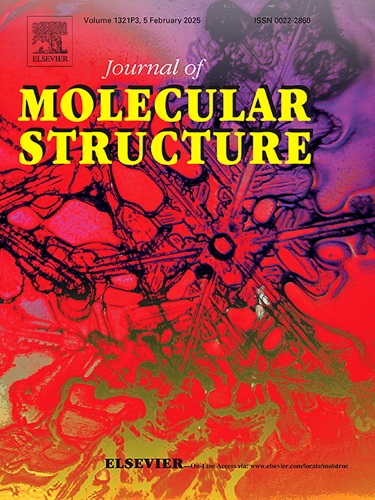Structure and optical properties of lanthanide complexes with scorpionate-like bis-carbacylamidophosphate ligand tetramethyl[pyridine-2,6-diyldi(iminocarbonyl)]diamidophosphate
IF 4
2区 化学
Q2 CHEMISTRY, PHYSICAL
引用次数: 0
Abstract
The solvent free lanthanide complexes [Ln(HL)2NO3] (Ln = Eu, Gd, Tb) with scorpionate type bis-carbacylamidophosphate ligand tetramethyl[pyridine-2,6-diyldi(iminocarbonyl)]diamidophosphate (H2 L) were synthesized. IR, diffuse reflectance, and luminescence spectroscopy measurements were carried out for their characterization. The crystal structure of the gadolinium complex was solved. It has been established that the ligands are coordinated to the lanthanide ion in a scorpionate way with formation of six-membered and twelve-membered metal cycles. H2L, [HL]− and NaHL were theoretically studied by DFT calculations. The analysis of the HOMO-LUMO gap has shown that the anion [HL]−is less stable than the molecular form of the ligand, however, the sodium cation in NaHL crystal structure stabilizes the deprotonated form of the ligand. The DFT quantum chemical calculations of the vibrational wavenumbers were performed for the H2L and NaHL. The europium and terbium complexes exhibit sensitized f-f luminescence with decay times at room temperature equal to 1.63 and 1.96 ms, respectively. Based on luminescence excitation spectra, the ligand-to-metal energy transfer in the europium complex was found to be strongly temperature dependent.
本研究合成了无溶剂镧系元素配合物 [Ln(HL)2NO3](Ln = Eu、Gd、Tb)与蝎酸盐型双羰基氨基磷酸盐配体四甲基[吡啶-2,6-二基(亚氨基羰基)]二氨基磷酸盐(H2 L)。对它们的特性进行了红外光谱、漫反射光谱和发光光谱测量。解决了钆配合物的晶体结构。结果表明,配体与镧系离子以蝎酸盐方式配位,形成了六元和十二元金属循环。通过 DFT 计算对 H2L、[HL]- 和 NaHL 进行了理论研究。对 HOMO-LUMO 间隙的分析表明,阴离子 [HL]- 的稳定性低于配体的分子形式,而 NaHL 晶体结构中的钠离子则稳定了配体的去质子化形式。对 H2L 和 NaHL 的振动波数进行了 DFT 量子化学计算。铕和铽配合物显示出敏化的 f-f 发光,室温下的衰减时间分别为 1.63 和 1.96 毫秒。根据发光激发光谱,发现铕络合物中配体到金属的能量转移与温度密切相关。
本文章由计算机程序翻译,如有差异,请以英文原文为准。
求助全文
约1分钟内获得全文
求助全文
来源期刊

Journal of Molecular Structure
化学-物理化学
CiteScore
7.10
自引率
15.80%
发文量
2384
审稿时长
45 days
期刊介绍:
The Journal of Molecular Structure is dedicated to the publication of full-length articles and review papers, providing important new structural information on all types of chemical species including:
• Stable and unstable molecules in all types of environments (vapour, molecular beam, liquid, solution, liquid crystal, solid state, matrix-isolated, surface-absorbed etc.)
• Chemical intermediates
• Molecules in excited states
• Biological molecules
• Polymers.
The methods used may include any combination of spectroscopic and non-spectroscopic techniques, for example:
• Infrared spectroscopy (mid, far, near)
• Raman spectroscopy and non-linear Raman methods (CARS, etc.)
• Electronic absorption spectroscopy
• Optical rotatory dispersion and circular dichroism
• Fluorescence and phosphorescence techniques
• Electron spectroscopies (PES, XPS), EXAFS, etc.
• Microwave spectroscopy
• Electron diffraction
• NMR and ESR spectroscopies
• Mössbauer spectroscopy
• X-ray crystallography
• Charge Density Analyses
• Computational Studies (supplementing experimental methods)
We encourage publications combining theoretical and experimental approaches. The structural insights gained by the studies should be correlated with the properties, activity and/ or reactivity of the molecule under investigation and the relevance of this molecule and its implications should be discussed.
 求助内容:
求助内容: 应助结果提醒方式:
应助结果提醒方式:


